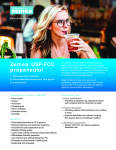Xylitol's potential beyond gum explored
could prevent the formation of undesirable brown pigments and
enhance beverage formulations, suggests new research.
In addition to protecting the anti-microbial properties of potassium sorbate, adding xylitol and aspartame to the system was found to produce a synergistic effect on sweetness intensity, states the report in the journal LWT - Food Science and Technology .
"These results stand out the advantage of the use of xylitol as well as the importance of an appropriate choice of the additives and food ingredients to use in the formulation of modified products with lower sugar content to optimise their quality," wrote the researchers, led by Carmen Campos from the Universidad de Buenos Aires.
"This recommendation is based on conclusions of studies perform with aqueous model systems and on the expectation that the same behaviour will be shown by food products," they added.
Xylitol is a white crystalline substance that looks and tastes like sugar and is found as an ingredient in anti-cavity chewing gum.
Unlike many artificial sweeteners, xylitol can be used in applications that require high temperature, such as baking and pasteurisation.
This, claims some experts, coupled with sweetness that is the same as table sugar, teaspoon for teaspoon, results in the easy replacement of table sugar with xylitol in most food applications.
The new study investigated the interactions between xylitol, aspartame and glucose in acidic liquid systems (pH 3), formulated with potassium sorbate (KS).
According to background information in the article, KS suffers an oxidative degradation in aqueous solutions, which favours the development of brown pigments (browning).
"The KS degradation and the browning development can affect the microbial stability and the sensory quality of the food, respectively," added the researchers.
Campos and co-workers report that the degradation of KS decreased with increasing use of aspartame from 0.05 to 0.5 grams per 100 grams.
"In general, as expected, presence of aspartame, xylitol or glucose and their mixtures increased the sweetness and they also diminished the sourness of the systems," they wrote.
Using the xylitol as a humectant, or softening agent, the degradation of aspartame was also minimised, while the browning development was diminished.
The combination of aspartame and xylitol enhanced the sweetness intensity of the system, added the researchers.
"The use of more than one sweetener might allow diminishing the amount of each one of them to assure a specific sweet level," concluded Campos and co-workers.
Xylitol's health benefits Xylitol has also received academic backing within Europe.
Last year the Scottish Intercollegiate Guidelines Network, which provides healthcare guidelines, included xylitol in recommendations encouraging consumers to look after their teeth.
The network said that consumers should use non-sugar sweeteners, in particular xylitol, in food and drink, and should be encouraged to use sugar-free chewing gum, "particularly containing xylitol, when this is acceptable."
Xylitol belongs to the polyol family of sugar alcohols and is a naturally occurring 5-carbon polyol sweetener found in a host of fruits and vegetables.
As sweet as sucrose, xylitol is the sweetest of all the polyols, but is said to have no after-taste and is safe for diabetics.
In Europe a handful of polyols - sorbitol, xylitol, lactitol, mannitol, maltitiol and isomalt - have been approved by the Scientific Committee for Food (SCF) for use in foodstuffs and fall under the 'additives' label.
The billion-euro market for polyols is growing at just under three per cent, compared to over eight per cent for high intensity sweeteners.
But dental benefits could open up new sales growth areas for this polyol sugar replacer.
Source: LWT - Food Science and Technology (Elsevier) Volume 41, Issue 4, Pages 611-619, doi: 10.1016/j.lwt.2007.05.004 "Interactions between aspartame, glucose and xylitol in aqueous systems containing potassium sorbate" Authors: M.F. Gliemmo, A.M. Calvino, O. Tamasi, L.N. Gerschenson and C.A. Campos













